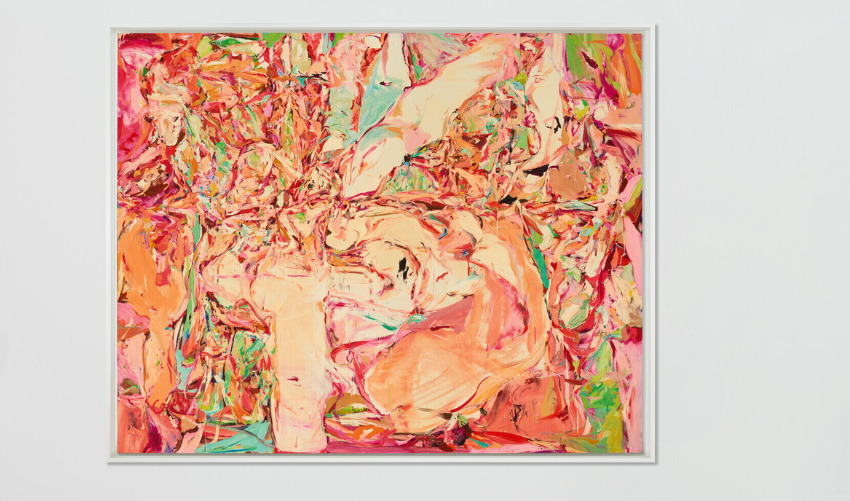This artwork pulls you in with its bold colors and striking details, inviting you to explore more than just what’s on the surface. If you want to understand the story behind this powerful piece and discover what makes Cecily Brown’s style so unique, keep reading.
Artist Background
Self-Portrait With a Hand by Cecily Brown offers a glimpse into the artist’s unique vision and style. Understanding the artist background helps us appreciate the layers and emotions behind this work. Cecily Brown’s journey as an artist shapes how she expresses herself on canvas.
Early Life And Influences
Cecily Brown was born in London in 1969. She grew up surrounded by art and culture, which deeply influenced her creative path. Her mother was a painter, and her father was a literary scholar. This mix of art and literature fueled her imagination from a young age.
Brown studied at the Slade School of Fine Art in London. Later, she moved to New York to continue her career. Her experiences in both cities exposed her to different art scenes and styles.
Key influences in Cecily Brown’s early life include:
- Abstract Expressionism
- Old Master paintings
- Pop culture and contemporary art
- The works of Willem de Kooning and Francis Bacon
These influences helped her develop a style that blends chaos with beauty. She often challenges traditional boundaries in painting.
| Influence | Description |
|---|---|
| Abstract Expressionism | Focus on spontaneous, emotional brushwork |
| Old Masters | Classical techniques and dramatic lighting |
| Pop Culture | Incorporation of modern themes and imagery |
Artistic Style And Themes
Cecily Brown’s style is known for its energetic brushstrokes and vibrant colors. She creates paintings that feel alive and full of movement. Her work often blurs the line between abstraction and figuration.
Brown’s themes focus on human emotion, desire, and the body. She explores ideas of sexuality and identity in bold, often provocative ways. Her paintings invite viewers to engage deeply with the forms and colors.
Main characteristics of her artistic style include:
- Loose, gestural brushwork
- Complex layering of paint
- Mix of abstract shapes and recognizable figures
- Strong use of color contrasts
Her paintings often feel like a dance between chaos and control. This tension creates a powerful visual impact. Themes of intimacy and vulnerability appear repeatedly, making her work personal yet universal.

Painting Description
The painting captures a moment of mystery and intensity. It invites viewers to explore the feelings behind the image. The brushwork and composition create a sense of movement and depth. This section describes the painting’s key features, focusing on its composition, elements, color, and texture.
Composition And Elements
The composition of Self-Portrait With a Hand is bold and dynamic. Cecily Brown places the hand in the foreground, making it the focal point. This unusual choice draws attention to the gesture rather than the face alone. The hand partially covers the face, creating a sense of concealment and intrigue.
Key elements of the composition include:
- The Hand: Large, expressive, and textured, it dominates the canvas.
- The Face: Partially visible with soft, blurred features.
- Background: Abstract and muted, it supports the main subjects without distraction.
The painting uses loose brushstrokes. These strokes give a feeling of movement and emotion. The face and hand are not sharply defined. This adds to the painting’s raw and spontaneous look.
| Element | Description | Impact |
|---|---|---|
| Hand | Large, textured, in the foreground | Focuses attention and creates mystery |
| Face | Soft, blurred, partly hidden | Suggests emotion and vulnerability |
| Background | Abstract, muted tones | Enhances depth and mood |
The contrast between sharp and soft edges guides the eye across the painting. The hand’s size compared to the face creates a dramatic tension. This tension invites viewers to think about identity and self-expression.
Use Of Color And Texture
Cecily Brown uses color and texture to bring the painting to life. The palette is rich but controlled, combining warm and cool tones. These colors create a balance between warmth and distance.
Colors used include:
- Deep reds and pinks for the skin and hand
- Soft whites and creams for highlights
- Dark blues and grays in the background
The texture is thick and layered. Brown applies paint with heavy brushstrokes, creating a tactile surface. This texture adds depth and physicality. It makes the hand appear almost three-dimensional.
The rough brushwork contrasts with smoother areas on the face. This contrast highlights the emotional intensity of the piece. The layering of paint gives a sense of complexity and movement.
| Aspect | Details | Effect |
|---|---|---|
| Color Palette | Warm reds and cool blues | Creates emotional tension |
| Brushwork | Thick, layered, expressive strokes | Adds depth and texture |
| Surface | Varied smooth and rough areas | Highlights movement and focus |
The combination of color and texture gives the painting its powerful presence. It feels alive and personal. The viewer senses the artist’s energy and inner world through these choices.
Symbolism Of The Hand
Brown’s brushstrokes highlight the hand’s role in communication and creativity. This focus invites viewers to think about what the hand means in our lives and art. The symbolism of the hand in this self-portrait reveals layers of meaning about how we show ourselves and connect with the world.
Gesture And Meaning
The hand gesture in Brown’s portrait carries strong meaning. It is not just a pose but a message. The hand appears dynamic, full of movement and emotion. This gesture suggests:
- Expression: The hand communicates feelings without words.
- Action: It shows the power to create and change.
- Protection: The hand partly covers the face, hinting at vulnerability.
- Invitation: The open fingers can welcome or reach out.
Each finger’s position adds to the gesture’s complexity. The hand’s placement near the face also connects thoughts and actions. The artwork uses color and texture to enhance this effect. Soft and rough strokes around the hand create tension and energy.
| Aspect | Meaning |
|---|---|
| Open palm | Openness, honesty, connection |
| Fingers spread | Energy, tension, movement |
| Hand near face | Protection, contemplation, identity |
This symbolism makes the hand a central element that guides how we read the self-portrait.
Connection To Identity
The hand in Brown’s self-portrait also links deeply to identity. It acts like a bridge between the inner self and the outside world. The hand shows how the artist presents herself and controls her image. It reminds us that identity is both personal and public.
Here are key points about the hand’s connection to identity:
- Self-expression: The hand shapes how we show who we are.
- Creativity: It is a tool for making art, shaping identity.
- Boundaries: The hand can hide or reveal parts of the face, controlling visibility.
- Touch and connection: Hands link us to others through contact.
Brown’s use of the hand suggests a complex self-awareness. It shows the struggle between revealing and concealing identity. The hand is both a mask and a mirror. It reflects the artist’s feelings and her desire to communicate.
In this way, the hand becomes a symbol of the self, not fixed but fluid and evolving. It invites viewers to consider how our identities are shaped by what we choose to show or hide.
Techniques And Medium
Self-Portrait With a Hand by Cecily Brown showcases her unique style through bold techniques and thoughtful medium choices. The artwork reveals layers of emotion and movement, created by her skilled use of brushwork and materials.
Brushwork And Materials
Cecily Brown’s brushwork stands out for its energy and fluidity. She applies paint in thick, sweeping strokes that create a sense of motion and depth. The texture is rough yet controlled, giving the portrait a vivid, almost tactile quality.
Brown uses high-quality oil paints that enhance color richness and blending. The surface of the canvas becomes a playground for her dynamic brush movements.
- Thick impasto technique: Layers of paint build texture and shadow.
- Loose, expressive strokes: Add emotion and spontaneity.
- Color layering: Creates depth and vibrancy.
Her brushwork combines control and freedom. The mix of smooth and rough textures draws the viewer’s eye across the canvas. This technique highlights the emotional tension in the self-portrait.
Innovative Approaches
Cecily Brown breaks traditional portrait rules with fresh, innovative methods. She blends abstract forms with figurative elements, challenging how a self-portrait should look. Her approach creates a powerful balance between chaos and clarity.
Brown experiments with:
- Layering: Multiple paint layers create complexity and mystery.
- Blurring details: Faces and hands partly dissolve into the background.
- Unconventional compositions: Cropped features and unexpected angles.
This innovation makes the portrait feel alive and unpredictable.
- Her use of partial abstraction invites personal interpretation.
- She pushes boundaries by mixing figuration with expressive gesture.
- The hand in the portrait becomes a symbol, not just a body part.
These choices reflect Brown’s goal to capture emotion beyond physical appearance. Her innovative style invites viewers to explore deeper layers of identity and feeling.
Critical Reception
Self-Portrait With a Hand by Cecily Brown has drawn much attention since its reveal. Critics have explored the painting’s complex style and emotional depth. The work blends abstract forms with figurative hints, challenging viewers to find personal meaning.
Reviews And Interpretations
Critics often praise Self-Portrait With a Hand for its bold brushwork and vibrant colors. Many find the painting both chaotic and intimate, showing Brown’s struggle with identity and expression. The hand, a key element, symbolizes control and vulnerability at once.
- Expressive brushstrokes: Seen as a way to convey emotion beyond clear images.
- Color contrasts: Create tension and draw attention to specific areas.
- Ambiguity: Encourages viewers to interpret the hand and face in different ways.
Some reviewers compare Brown’s approach to Abstract Expressionism, noting her fresh take on self-portraiture. Others focus on psychological themes, pointing out how the painting reveals inner conflict.
| Aspect | Common Critical View |
|---|---|
| Technique | Dynamic, loose, yet controlled brushwork |
| Emotional Impact | Evokes tension, vulnerability, and strength |
| Symbolism | Hand as a metaphor for self-control and fragility |
Overall, the painting invites ongoing discussion about how identity is shown through art.
Impact On Contemporary Art
Self-Portrait With a Hand influences many artists and viewers in the contemporary art scene. Its blend of abstraction and figuration offers a new path for self-expression. Brown’s work challenges traditional portrait rules.
Artists find inspiration in her loose yet deliberate style. This encourages experimentation with form and color. The painting’s emotional honesty sets a standard for personal storytelling in art.
- Encourages breaking boundaries between abstract and figurative art
- Promotes emotional depth in portraiture
- Supports the use of symbolic elements to explore identity
Museums and galleries often include Brown’s works in exhibitions focused on modern self-portraiture. Her impact goes beyond style. She helps shape conversations about how artists represent themselves today.
Here is a simple overview of the painting’s impact:
| Area | Effect |
|---|---|
| Style Innovation | Mixes abstract and figurative techniques |
| Thematic Depth | Explores identity with emotional honesty |
| Artistic Influence | Inspires contemporary artists to be bold |
Brown’s painting remains a reference point for artists examining personal themes.




